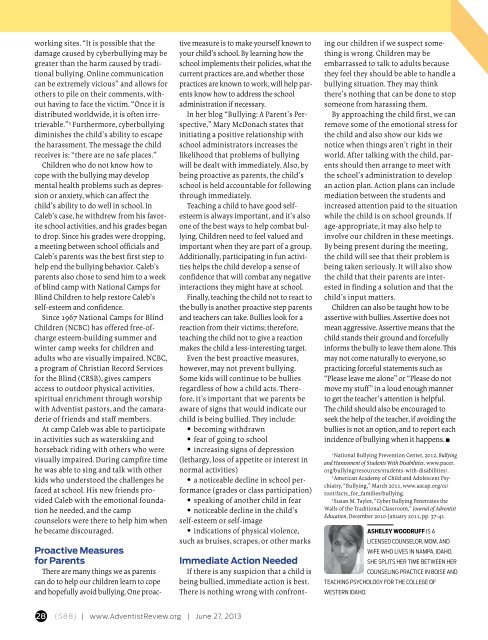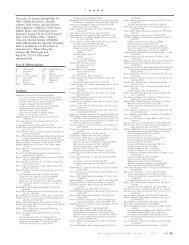Download PDF - Adventist Review
Download PDF - Adventist Review
Download PDF - Adventist Review
- No tags were found...
Create successful ePaper yourself
Turn your PDF publications into a flip-book with our unique Google optimized e-Paper software.
working sites. “It is possible that the<br />
damage caused by cyberbullying may be<br />
greater than the harm caused by traditional<br />
bullying. Online communication<br />
can be extremely vicious” and allows for<br />
others to pile on their comments, without<br />
having to face the victim. “Once it is<br />
distributed worldwide, it is often irretrievable.”<br />
3 Furthermore, cyberbullying<br />
diminishes the child’s ability to escape<br />
the harassment. The message the child<br />
receives is: “there are no safe places.”<br />
Children who do not know how to<br />
cope with the bullying may develop<br />
mental health problems such as depression<br />
or anxiety, which can affect the<br />
child’s ability to do well in school. In<br />
Caleb’s case, he withdrew from his favorite<br />
school activities, and his grades began<br />
to drop. Since his grades were dropping,<br />
a meeting between school officials and<br />
Caleb’s parents was the best first step to<br />
help end the bullying behavior. Caleb’s<br />
parents also chose to send him to a week<br />
of blind camp with National Camps for<br />
Blind Children to help restore Caleb’s<br />
self-esteem and confidence.<br />
Since 1967 National Camps for Blind<br />
Children (NCBC) has offered free-ofcharge<br />
esteem-building summer and<br />
winter camp weeks for children and<br />
adults who are visually impaired. NCBC,<br />
a program of Christian Record Services<br />
for the Blind (CRSB), gives campers<br />
access to outdoor physical activities,<br />
spiritual enrichment through worship<br />
with <strong>Adventist</strong> pastors, and the camaraderie<br />
of friends and staff members.<br />
At camp Caleb was able to participate<br />
in activities such as waterskiing and<br />
horseback riding with others who were<br />
visually impaired. During campfire time<br />
he was able to sing and talk with other<br />
kids who understood the challenges he<br />
faced at school. His new friends provided<br />
Caleb with the emotional foundation<br />
he needed, and the camp<br />
counselors were there to help him when<br />
he became discouraged.<br />
Proactive Measures<br />
for Parents<br />
There are many things we as parents<br />
can do to help our children learn to cope<br />
and hopefully avoid bullying. One proac-<br />
tive measure is to make yourself known to<br />
your child’s school. By learning how the<br />
school implements their policies, what the<br />
current practices are, and whether those<br />
practices are known to work, will help parents<br />
know how to address the school<br />
administration if necessary.<br />
In her blog “Bullying: A Parent’s Perspective,”<br />
Mary McDonach states that<br />
initiating a positive relationship with<br />
school administrators increases the<br />
likelihood that problems of bullying<br />
will be dealt with immediately. Also, by<br />
being proactive as parents, the child’s<br />
school is held accountable for following<br />
through immediately.<br />
Teaching a child to have good selfesteem<br />
is always important, and it’s also<br />
one of the best ways to help combat bullying.<br />
Children need to feel valued and<br />
important when they are part of a group.<br />
Additionally, participating in fun activities<br />
helps the child develop a sense of<br />
confidence that will combat any negative<br />
interactions they might have at school.<br />
Finally, teaching the child not to react to<br />
the bully is another proactive step parents<br />
and teachers can take. Bullies look for a<br />
reaction from their victims; therefore,<br />
teaching the child not to give a reaction<br />
makes the child a less-interesting target.<br />
Even the best proactive measures,<br />
however, may not prevent bullying.<br />
Some kids will continue to be bullies<br />
regardless of how a child acts. Therefore,<br />
it’s important that we parents be<br />
aware of signs that would indicate our<br />
child is being bullied. They include:<br />
• becoming withdrawn<br />
• fear of going to school<br />
• increasing signs of depression<br />
(lethargy, loss of appetite or interest in<br />
normal activities)<br />
• a noticeable decline in school performance<br />
(grades or class participation)<br />
• speaking of another child in fear<br />
• noticeable decline in the child’s<br />
self-esteem or self-image<br />
• indications of physical violence,<br />
such as bruises, scrapes, or other marks<br />
Immediate Action Needed<br />
If there is any suspicion that a child is<br />
being bullied, immediate action is best.<br />
There is nothing wrong with confronting<br />
our children if we suspect something<br />
is wrong. Children may be<br />
embarrassed to talk to adults because<br />
they feel they should be able to handle a<br />
bullying situation. They may think<br />
there’s nothing that can be done to stop<br />
someone from harassing them.<br />
By approaching the child first, we can<br />
remove some of the emotional stress for<br />
the child and also show our kids we<br />
notice when things aren’t right in their<br />
world. After talking with the child, parents<br />
should then arrange to meet with<br />
the school’s administration to develop<br />
an action plan. Action plans can include<br />
mediation between the students and<br />
increased attention paid to the situation<br />
while the child is on school grounds. If<br />
age-appropriate, it may also help to<br />
involve our children in these meetings.<br />
By being present during the meeting,<br />
the child will see that their problem is<br />
being taken seriously. It will also show<br />
the child that their parents are interested<br />
in finding a solution and that the<br />
child’s input matters.<br />
Children can also be taught how to be<br />
assertive with bullies. Assertive does not<br />
mean aggressive. Assertive means that the<br />
child stands their ground and forcefully<br />
informs the bully to leave them alone. This<br />
may not come naturally to everyone, so<br />
practicing forceful statements such as<br />
“Please leave me alone” or “Please do not<br />
move my stuff” in a loud enough manner<br />
to get the teacher’s attention is helpful.<br />
The child should also be encouraged to<br />
seek the help of the teacher, if avoiding the<br />
bullies is not an option, and to report each<br />
incidence of bullying when it happens. n<br />
1<br />
National Bullying Prevention Center, 2012, Bullying<br />
and Harassment of Students With Disabilities, www.pacer.<br />
org/bullying/resources/students-with-disabilities/.<br />
2<br />
American Academy of Child and Adolescent Psychiatry,<br />
“Bullying,” March 2011, www.aacap.org/cs/<br />
root/facts_for_families/bullying.<br />
3<br />
Susan M. Taylor, “Cyber Bullying Penetrates the<br />
Walls of the Traditional Classroom,” Journal of <strong>Adventist</strong><br />
Education, December 2010-January 2011, pp. 37-41.<br />
ASHELEY WOODRUFF IS A<br />
LICENSED COUNSELOR, MOM, AND<br />
WIFE WHO LIVES IN NAMPA, IDAHO.<br />
SHE SPLITS HER TIME BETWEEN HER<br />
COUNSELING PRACTICE IN BOISE AND<br />
TEACHING PSYCHOLOGY FOR THE COLLEGE OF<br />
WESTERN IDAHO.<br />
28 (588) | www.<strong>Adventist</strong><strong>Review</strong>.org | June 27, 2013

















